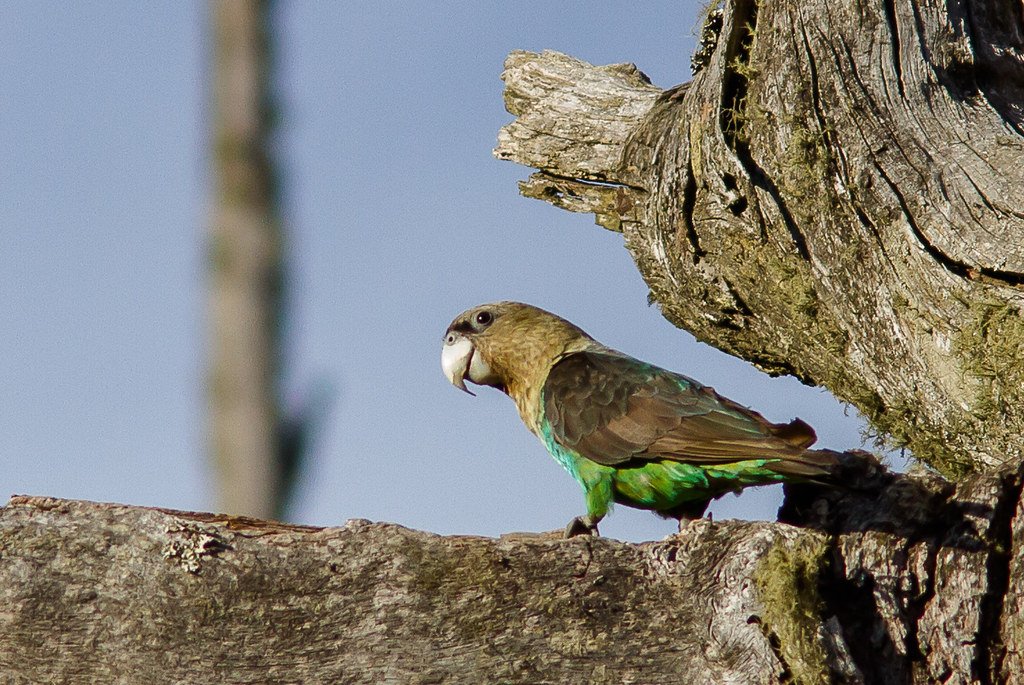
Conserving The Cape Parrot
The Cape Parrot Project aims to conserve the Cape Parrot by using research to fill key knowledge gaps and partnering with local communities for habitat restoration.
We began supporting the Cape Parrot Project (CPP) in 2024 towards establishing a Transkei exploration node.
The northern portion of the Eastern Cape (former-Transkei homeland) falls within the Pondoland-Albany-Maputaland Hotspot of Biodiversity and harbours a significant portion of South Africa’s limited indigenous forest cover, including Transkei Mistbelt forests of the Southern mistbelt group inland, and Pondoland scarp and Transkei coastal forest of the Scarp group at the coast. This area includes the regionally important Umzimvubu catchment, within which four national Important Bird and Biodiversity Areas occur. The endangered and endemic Cape Parrot Poicephalus robustus depends on these forests for survival, as do many other forest-dependent species. The Cape Parrot is listed as “Vulnerable” on the IUCN Red List of Threatened Species, but “Critically Endangered” within South African national law, due to its small population size (~2000 individuals across 3 sub-populations) and projected declining population trend. Recent estimates suggest a population of <120 Cape Parrots in the former-Transkei region (CPBBD report, 2023), however Cape Parrots and forest biodiversity have been severely under-surveyed in this region, which is consequently recognized as a major “biogap” in the country.
The project stands to contribute to expanded conservation action for Cape Parrots through:
● Conduct observations to provide a comprehensive and updated understanding of the Cape Parrot population
● Building capacity to conduct species and habitat surveys in ant under-surveyed area
● Enhancing local participation by conducting semi-structured interviews with forest-edge communities,
● Developing citizen science engagement through online and social media platforms
Project aims and objectives
This project aims to conduct exploratory research to improve our knowledge of an under-studied sub-population of Cape Parrots in the former Transkei region of the Eastern Cape; and inform future development of a permanent forest conservation node in this ecologically important and threatened region. Specific objectives of this study are to:
● Gain insights into Cape Parrot presence/absence in key forests using direct and indirect observation data
● Derive preliminary local estimates of Cape Parrot abundance in key forests
● Derive preliminary insights into coastal population vs. inland population behaviour and movement patterns, i.e. determine whether coastal population are resident or exhibit elevation migration patterns etc.
● Locate important roosting and gathering trees in and around key forests
● Gain preliminary insights into Cape Parrot use of non-forest food sources, including pecan nut trees and/or orchards
● Identify potential breeding sites/forests with breeding pairs
● Establish local Cape Parrot Champion WhatsApp groups to aid citizen science reporting of Cape Parrot observations in the region
Study Area
The proposed study area for this exploratory research extends from Bizana to Engcobo along an east-west gradient; and from Kokstad in the north, to Port St Johns in the south (Figure left), falling within the Umzimvubu catchment. Based on the geographical clustering of forests in this region, three focal survey blocks - one coastal and two inland - have been identified. The coastal block comprises predominantly Pondoland Scarp and Transkei coastal forest; while the two inland blocks support Transkei mistbelt forest.
Study area extending from Bizana to Engcobo; and Kokstad to Port St Johns, within which three study blocks are identified: Coastal block (blue); Inland west (orange); and Inland east (yellow). Yellow points show CPP and BirdLasser observations and orange points show GBIF observations (SABAP2, iNaturalist & eBird).



